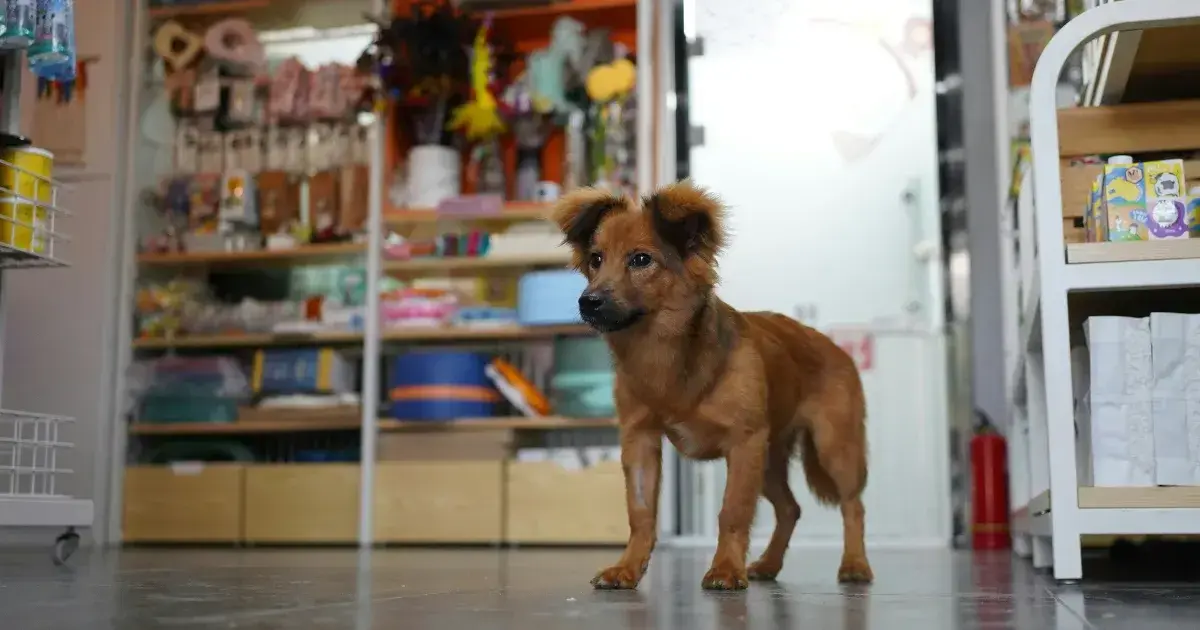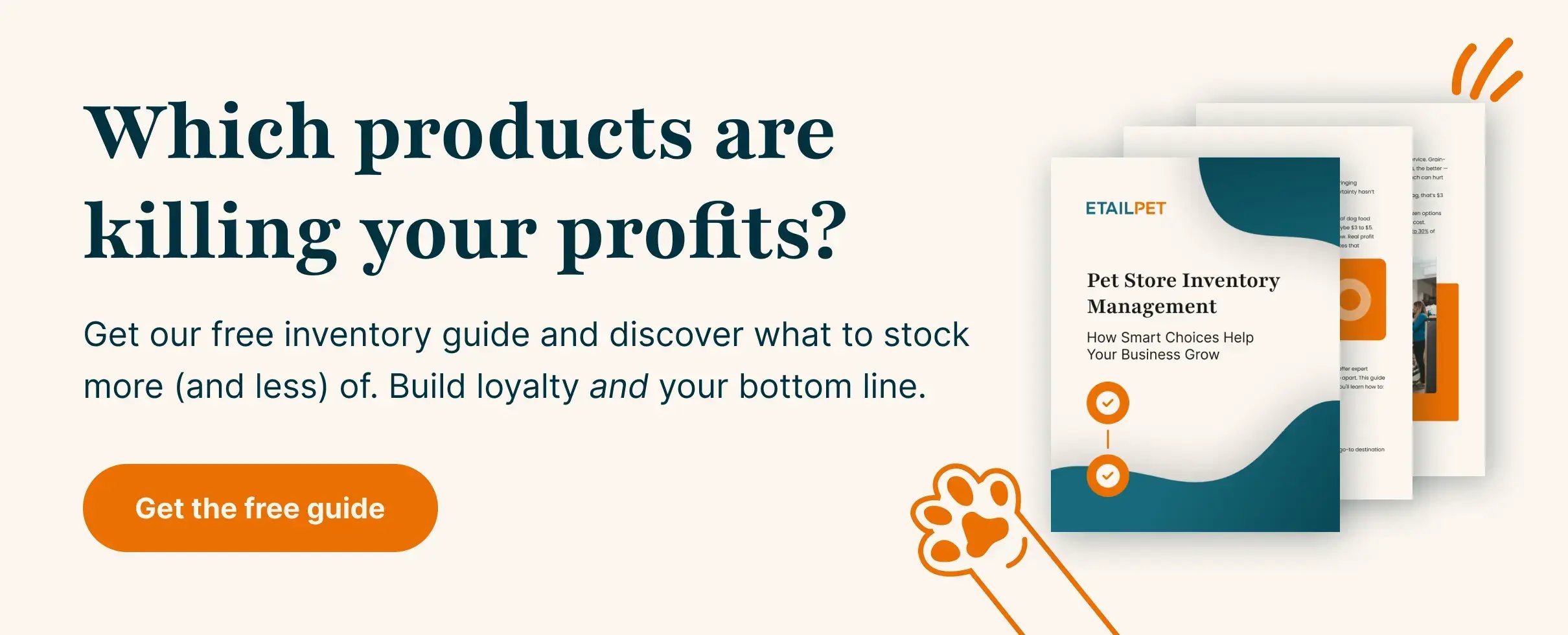
How would you rate your pet store’s layout?
To succeed in the pet retail industry, you need quality products, reasonable prices, and friendly customer service. Another (often overlooked) factor is the design of your pet store — and it has a direct impact on customer acquisition and sales volume.
But what makes your layout top-notch? A great store design makes it easy for customers to find everything they’re looking for, and creates interest in products that weren’t on their list. To achieve this, you need a simple, organized pet store layout that highlights your most popular products while exposing customers to new arrivals, seasonal items, and goods on clearance.
In this blog, we’ll discuss seven design strategies for creating the perfect pet store layout, from setting up exterior signage to arranging impulse buys.
Let’s dive in.
1. Create Unique Branding
You want your business to be memorable and instantly recognizable to customers — whether they see a social media post, an online ad, a flyer, or your brick-and-mortar location.
This is where branding comes into play, and color is a great place to start. Choose a few colors and use them around your store, in your logo, on product tags, and even on employee uniforms.
Your logo is the symbol of your brand, so make sure it fits your store. Use it on your building’s exterior, on social media channels, and anywhere else people see your business. Some pet stores choose to use a “mascot” — a character, like a dog or cat, as part of their logo.
Remember to keep these visual elements consistent in style, including:
- Colors
- Designs
- Fonts
- Photos
- Videos
When these match, you create a unified brand identity. Including these brand elements is an essential step in creating a great pet store layout.
Related Read: A Guide to Pet Store Website Design and 3 Inspiring Examples
2. Divide Sections Logically
Sorting your products into logical categories and organizing them clearly makes things easier for you and for customers. Start by creating sections for various kinds of pets — everything from puppies to parakeets.
Within each of these sections, create subsections for different pet needs (think food, toys, accessories, and grooming supplies). Customize each section with specific items like fish tanks, dog beds, or bird feeders.
You need to find the best display equipment for different products. While dog kennels and large bags of dog food are best placed on large, industrial-grade shelves, small packages of dog treats can be placed on smaller shelves and racks.
For collars and leashes, try hanging them on a wall with hooks instead of placing them on shelves, so the customer can see all options. For individually wrapped treats, you can use smaller bins.
It’s easy to just throw items on the closest shelf, but if you take the time and effort to be strategic, you can create a better customer experience and increase sales.
Related Read: Pet Store Inventory Management: 8 Tips & Tools for Success
3. Let Signage Guide and Persuade
Signage is a must if you want to help customers identify and navigate your store. Make sure it’s obvious your business is a pet store from its exterior using signage, design, and window displays. These signs should use readable fonts and clear images, and be visible from across the store — and remember to clearly delineate sections for different kinds of pets.
Ensure product and pricing labels are clear and readable, too. If customers don’t know where to go, they’re more likely to leave empty-handed.
4. Stage Displays That Sell
In-store product displays are a great way to highlight items you want to push, and there are several different ways to set them up:
- Window Displays: Set up these displays to give passersby a good idea of your stock and showcase your best products.
- Interior Displays: Place new arrivals or clearance items on your interior displays (think eye-level i). If a certain brand of dog treats has been sitting on your shelves, placing this product in a display encourages customers to give it a try.
- Endcaps: Strategically rotate your endcaps regularly with bestsellers, seasonal picks, clearance items, or other products you want to sell quickly.
A display is a great place for cross-selling. This means placing items commonly purchased together next to each other to encourage customers to buy both — for example, dog food and treats, collars and leashes, or assorted grooming products.
5. Prepare the Checkout Area With Impulse Buys
The checkout counter is traditionally where retailers put impulse buys — small, often high-margin items that customers decide to buy at the last minute. Creating displays of these inexpensive products helps you increase the value of each sale.
Here are a few examples of impulse buys:
- Individually wrapped treats and chews
- Small pet toys, like catnip mice and tennis balls
- Grooming items, like combs or hairbrushes
- Paw cleaner
Most of these items should be priced under $10. Keep this section stocked as consistently as possible so customers always have plenty to choose from. Even small details like this help you improve your pet store’s bottom line.
Related Read: Pet Store Profit Margins by Product Category: What Actually Makes Money
6. Set Up Aisles for Clear, Comfortable Navigation
When you design your pet store, you want to create a clear path from the door, around the aisles, and to the checkout counter.
While spacing things out gives a customer room to look for what they need, having a suggested path encourages them to browse the entire store. Avoid dead ends and design aisles to lead from one to another.
Aisles must be at least 3 feet wide to comply with accessibility standards, but wider gaps give customers more room to navigate the pet store. Make sure shelves aren’t so high that customers can’t see other product sections — hanging signs above them makes them more visible.
7. Organize the Backroom for Faster Restocking
Remember to organize your pet store’s backroom, too. While it isn’t visible to customers, a well-kept backroom keeps inventory moving and shelves stocked. First, you need a station to put newly-received inventory — then, set up shelves, racks, and bins to store items before they're ready to go out on the sales floor.
You need to find the right equipment to store different kinds of inventory. Large items should be stored on shelves, close to the floor to prevent a safety hazard. Smaller items can go in bins, which can be stored in a large bin organizer. These storage units use vertical space, rather than occupying floor space. Label backroom shelves by pet and product category – this helps employees save time when organizing stored inventory.
Using efficient storage strategies and creating a consistent process to take products from arrival to shelf saves time and helps you increase inventory turnover.
Design the Ideal Pet Store Layout With eTailPet
Don’t underestimate the influence of your pet store’s layout and design. The right branding and organization makes a customer’s experience more memorable and convenient, and motivates them to buy more.
As you set up your pet store, use distinct branding, sort products by category, and put up clear signage. Fill your store with strategic displays, including impulse buys, and invest time into organizing the backroom. With consistent effort, you can maintain a positive reputation among your customers.
Need help keeping track of your inventory? A cloud-based point of sale (POS) system is the answer. eTailPet is an all-in-one POS system designed specifically for pet stores.
Our all-in-one retail solution includes the general features all retail stores need, like payment processing, inventory management, and sales reporting, as well as pet-specific features like access to pet product catalogs, service modules, and a direct integration with Astro Loyalty.
To see what eTailPet can do for your pet store, schedule a demo today!

 By
By 






